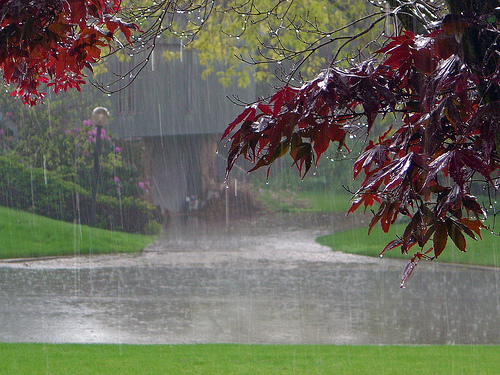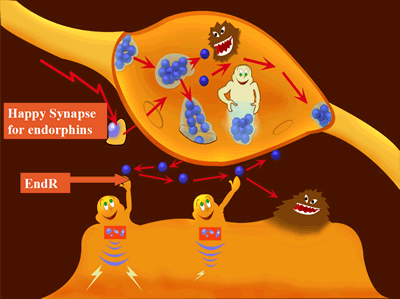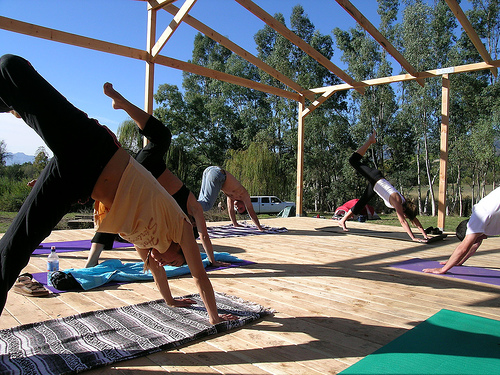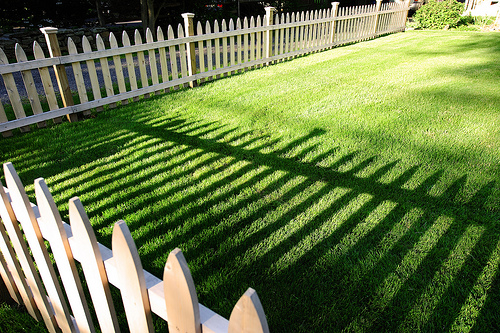The seasons are shifting. For most places, colder weather and less daylight means the steady approach of winter. In my home in Northern California, summer lasts through October. The sun shines steadily, temperature drops to a tolerable high 60’s and not a drop of rain is seen. Suddenly, it’s dark by 5:00pm and the cuffs of your pants are constantly wet from trudging through the rain puddles, you know that the dreaded winter is here.
In California, we definitely have seasons.
They may not be as apparent as in other parts of the country or world, but they are still here, believe me. Spring is sunny and foliage is growing, little rain. Summer is sunny no rain and hot. Fall is sunny but not so hot, and some leaves change color. Winter is rainy and cold.
See, seasons.
Since most Californians love the sun, and get quite used to it with about 9 months of uninterrupted vitamin D consumption, winter is an unhappy time for a lot of us, me included.

Go Away Rainy Day: Less sunlight, more darkness, rain and cold can cause people to be suffer from a subset of depression known as Seasonal Affective Disorder (SAD), even more people are affected by a more mild version of "winter blues," causing an overall depressed mood, melancholy and mild symptoms of depression during the winter months. Photo credit: Flickr user laffy4k
This phenomenon is not an isolated event. If the darkness, wetness, and cold get you down during the winter months and you experience increased stress due to the holidays and other pressures, then you are not alone. SAD, or Seasonal Affective Disorder, may affect over 10 million Americans during winter. Even more may experience the milder “winter blues,” that cause increased depressive mood and anxiety. SAD is recognized by the American Psychiatric Association as a subtype of major depressive episode. SAD may be experienced by one or many symptoms of depression such as fatigue, increased need for sleep, decreased energy, weight gain, anxiety, difficulty concentrating, loss of interest and desire to be alone, increased craving for sweets, thoughts of death or suicide. Symptoms begin in fall, reach their peak in winter and resolve in the spring.
Although the exact cause of SAD remains unknown. Researchers speculate that SAD is connected to the amount of sun and light which if changed, can alter our biological clock and natural rhythms. Exposure to sunlight regulates mood, sleep and hormones and due to decreased sunlight in winter, biological clock may be delayed and run more slowly. Symptoms of SAD increase with rise in latitude. Thus, there are more people in Maine who experience SAD than those who live in Florida. Other theories postulate that changes in sunlight can alter levels of neurotransmitters such as serotonin and may be affected in individuals with SAD.
People who suffer from severe SAD, whose symptoms interfere with daily life, can optfor treatment such as mood stabilizers, SSRI’s used to treat depression, or psychotherapy. Studies have also shown that exposure to special lamps known as light therapy can be an effective treatment for SAD either alone or in combination with other treatments.
Light therapy, is treatment with specialized lamps that mimic the natural spectrum of sunlight. Daily treatment with specialized lamps, most effective in the mornings, can reset circadian rhythms and offset symptoms caused by SAD. Schools, such as the University of Wisconsin, offer SAD lamps for use by students and faculty.

Light Up Your Life: Research studies have seen that SAD lamps are an effective treatment for those who suffer from Seasonal Affective Disorder (SAD). Photo Credit: University of Wisconsin, Counseling Center
For those of us who may not suffer from severe SAD, but who do experience a moderate amount of “winter blues,” there are a number of tricks that you can do to keep your mind happy even when the weather gets you down. The trick lies in a handy family chemical in your brain: endorphins. These are the chemicals responsible for the rush likened to opiod use, or runner’s high, and is cause for feelings of general euphoria that can last up to hours after initial release.

Get Happy: Endorphins, released during times of physical or mental stress, give feelings of euphoria, and can be triggered a number of ways. Photo credit: University of Texas
Endorphins, more specifically, are a group of neurotransmitters in the brain that activate opiate receptors in the brain. Scientists hypothesize that endorphins are released when the body encounters stress. Thus when your body is stressed physically by vigorous exercise, endorphins are released, and whoosh, you are suddenly euphoric and pain free. Endorphins activation of opiate receptors produces an analgesic response, alleviating severe pain. Emotional stress can also cause a release of endorphins which act on the limbic system to reduce melancholy and anxiety.
That is the key. Endorphins are the body’s own defense for a depressive mood, and if you can help trigger an endorphin rush, you can chase away the winter blues. Here are some ways to keep up your endorphins and keep you blissful all winter long.
1) Exercise:
Stretch It Out: Exercising in winter can be tricky, but with some indoor tools, like a yoga mat and some weights, you can keep your endorphins flowing and stay fit this winter. Photo credit: Flickr user angela7dreams
I know what you’re thinking, “Erin you must be crazy to suggest that jogging in the rain is going to make me feel better about this whole winter situation!” That may be true. Outdoor exercises may not be the most optimal for a winter workout, which is why you should invest in some special indoor equipment for exercise indoors. For those of us who belong to a gym, use it. Cardio not only gets your blood pumping, but
triggers an endorphin rush, which can last for hours after your workout is done. Other indoor activities could help during winter months as well. Investing in a Yoga mat and a yoga/Pilates DVD or a pair of hand weights and resistance bands can get you a great workout for little cost.
It’s true. Engaging in intercourse not only increases your heart rate, but an orgasm triggers a flood of endorphins. Having sex in winter is just as easy as any other season, so light a fire in the fireplace, uncork that bottle of wine and endorphins away.
3) Eating Food:

Spicy: Peppers, due to their pain-causing spiciness, cause can endorphin release locally on the tongue as well as centrally in the brain. This is to relieve the body from the pain caused by eating the pepper. No pain, no gain. Photo credit: Flickr user jslander.
Certain foods, such as chili peppers and chocolate are known to release endorphins. Peppers trigger endorphins to shield the body from the pain caused on the tongue from the chemicals in the food. Cocoa has an addictive quality and when ingested, causes a release of endorphins. Therefore, chocolate is just good, and makes you feel good in return.
4) Experience some emotions:
Certain emotions can cause a release of endorphins if they cause a certain amount of stress on the body.
Significant laughter, fear or emotional experience can trigger endorphins. So, that means order up some Netflix or rent some movies. It could be a comedy, horror, thriller or drama. As long as you get involved in the content, endorphins ahead. Other triggers can be caused by viewing a piece of inspirational artwork or listening to your favorite music. Try visiting an interesting museum or enjoying a concert this winter.
5) Get some Sun:

Good Day Sunshine: Even though winter may have little to no visible sun, light can have just as much of an effect on cloudy days, so try to spend even a few minutes outside to help manage winter blues. Photo credit: Flickr user Mannequin-
Although the lack of sun may be the root of our problems, that doesn’t mean you have to live without it. Take advantage of the sun that does occur in the winter, and enjoy a few moments outdoors and take advantage of letting more light into your home. Researchers say that sunlight can trigger endorphins possibly as a protection against sunburn.
Other ways to avoid SAD:
If you suffer from Winter Blues, then there are also other ways to keep yourself from feeling the strain of winter. Along with maximizing your exposure to sunlight during the winter by opening up windows and spending time outdoors on sunny days, you can give yourself other opportunities to chase away winter blues. Color can change or affect one’s mood. Bright colors are known to lift spirits and give a happier mood. Colors like grey, black and other dark colors will depress mood, while colors like orange, yellow and red will give an impression of warmth and light, which can positively affect mood. So put on that red sweater or consider some seasonal décor for your home. Adding a little color to your life this winter may help your mood. Anxiety, stress and depression during the winter may be caused by lack of sunlight, but anxiety from work or other life related problems may also be piled on during the winter months. Identify which issues in your life are causing stress and give yourself easy steps to resolve them. For those that may experience lack of interest or other such symptoms of depression, try giving yourself a long-term project to do and sticking with it. Motivation to finish the project or involve yourself in a constructive outlet may take your mind off the lack of sun and focus on your project.Although millions may suffer from Winter Blues, with a little light, endorphins and some advice from your doctor, you don’t have to be quite as SAD this winter.
References:
Northern County Psychiatric Associates, Maryland
National Institutes of Health-Depression
Journal reference: Neuropsychopharmacology (DOI: 10.1038/sj.npp.1301560)






Comments